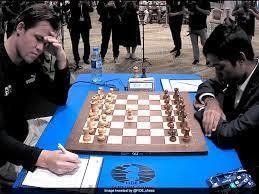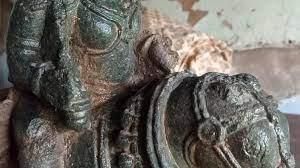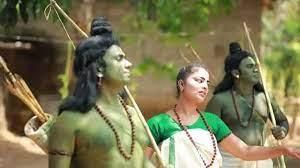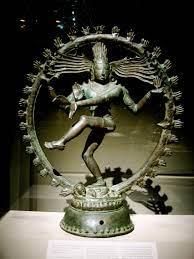History, Art & Culture - 2 | Current Affairs & Hindu Analysis: Daily, Weekly & Monthly - UPSC PDF Download
| Table of contents |

|
| Chess World Cup 2023 |

|
| Geographical Indication (GI) Tags |

|
| Mylara Cult |

|
| Seethakali Folk Art |

|
| Nataraja Statue |

|
| Konark Sun Temple |

|
Chess World Cup 2023
Magnus Carlsen clinched his inaugural title in the FIDE World Cup finals by triumphing over the Indian chess prodigy R. Praggnanandhaa in Baku, Azerbaijan. Notably, Praggnanandhaa has now become the second Indian, following in the footsteps of Viswanathan Anand, to reach a World Cup final.
- Despite Praggnanandhaa's spirited performance that earned him a place in the esteemed Candidates Tournament, he faced defeat in this particular match.
Regarding the FIDE World Cup:
- Initiated in 2000 by the International Chess Federation (FIDE), the FIDE World Cup has undergone various iterations. Since 2005, it has adopted a 128-player single-elimination format, playing a crucial role in the qualification process for the World Chess Championship.
- The structure involves seven rounds of "mini-matches" with two games each, followed by rapid and blitz tiebreaks if necessary. The final stage consists of four games before resorting to tiebreaks.
Regarding the Candidates Tournament:
- FIDE has been organizing the Candidates Tournament since 1950 to determine the challenger for the World Chess Championship. The winner of this tournament gets the opportunity to face the reigning World Champion. Historically held triennially until 1992, the tournament has followed a two-year cycle since 2013.
About the World Chess Championship:
- This championship decides the world champion in chess. In the 2023 championship, Ding Liren from China emerged victorious, defeating Ian Nepomniachtchi, while Magnus Carlsen chose not to defend his title.
Geographical Indication (GI) Tags
- Geographical Indication falls under the umbrella of Intellectual Property. The GI tag serves as an emblem for products originating from a distinct geographical location, showcasing unique characteristics developed over centuries, particularly in terms of special quality or reputation attributes.
- Granting this status to products verifies their authenticity and ensures that only registered authorized users can employ the popular product name. These products encompass naturally grown crops such as Assam Chilies or manufactured items like Jaipur Pottery.
- The issuance of GI tags is governed by the Geographical Indications of Goods (Registration and Protection) Act of 1999.
- The registration of a GI is initially valid for ten years, after which renewal is necessary. The infringement of GI tags constitutes a punishable offense under the law.
What are the benefits of a GI Tag?
- Legal protection for the products
- Prevention of unauthorized use of products bearing a GI tag
- Assistance for consumers in obtaining quality products with desired characteristics
- Promotion of economic prosperity for producers of GI-tagged goods by increasing their demand in national and international markets
- Provision for producers to claim a premium for their products, resulting in financial benefits
- Potential to generate consumer interest, subsequently boosting demand for a product and benefiting the producer.
What are the legalities related to GI Tag?
- It is covered as an element of intellectual property rights (IPRs) under the Paris Convention for the Protection of Industrial Property.
- At international level, GI is governed by World Trade Organisation’s (WTO’s) Agreement on Trade-Related Aspects of Intellectual Property Rights (TRIPS).
- In India, GI registration is governed by the Geographical Indications of goods (Registration and Protection) Act, 1999.
- This Act is administered by Controller General of Patents, Designs and Trade Marks, who is also Registrar of Geographical Indications and is based in Chennai, Tamil Nadu.
Facts:
- Darjeeling tea was the first product to accorded with GI tag in India.
Why in news?
- Odisha and West Bengal are fighting for GI of Rosogolla
- Odisha has been granted GI tag for “Odisha Rosogolla”
- Nilambur Teak of Kerala is awarded GI tag.
- Gobindobhog rice has been granted GI tag
- Seven commodities were granted Geographical Indication (GI) last year by the Indian patent office. It includes :
- Banaganapalle mangoes (Andhra Pradesh),
- Tulaipanji rice (West Bengal),
- Pochampally Ikat (Telangana),
- Gobindobhog rice (West Bengal),
- Durgi stone carvings and Etikoppaka toys (Andhra Pradesh)
- Chakshesang shawl (Nagaland).
- Alphonso mango from 5 districts of Maharashtra gets GI Tag.
- DIPP has unveiled a tricolour logo for geographical indication (GI) certified products. The logo has tagline “Invaluable Treasures of Incredible India” printed below it.
Mylara Cult
The recent unearthing of two sculptures in Basrur, situated in the Udupi district of Karnataka, provides evidence supporting the historical existence of the ancient Mylara cult in the coastal region.
Key findings
- The two sculptures bear a resemblance to artifacts from the 15th century A.D. and another from the 17th century A.D.
- They depict a royal hero seated on a horse, holding a sword in his right hand and a bowl in his left.
- However, the figure of Mylaladevi is absent on the back of the horse, and another sculpture depicting horses holding swords in their right hands was discovered in a different water body.
- Basrur served as a historic trading city during the Medieval period, attracting active participation from trading guilds like Uhayadesi, Nanadesi, and others.
About Mylara Cult
- Mylara is a folk deity, recognized as a manifestation of Lord Shiva.
- This deity, commonly referred to as Mailara in Karnataka and as Khandoba in Maharashtra, goes by various other names such as Khanderao and Khandnatha.
- The Mylara cult is prevalent in the southern part of India, encompassing regions in Karnataka, Maharashtra, Andhra Pradesh, and Tamil Nadu.
Seethakali Folk Art
The Perinad Seethakali Sangham, a member group, is ready to showcase their performance outside of Kerala for the first time.
About Seethakali
It is a distinctive centuries-old folk art form believed to have originated in Perinad, Kollam district, Kerala. The art form was first presented around 150 years ago by members of the Vedar and Pulayar communities.
Themes:
- Seethakali is centered around episodes from the Indian epic Ramayana. Mythical characters such as Rama, Seetha, Ravana, and Hanuman are vividly portrayed in these performances, depicting Seetha’s journey from accompanying Rama to the woods to her eventual ascent to the heavens.
Historical Context:
- In its early days, Seethakali was part of the Onam harvest festival. From the Atham star to the 28th day after Onam, performers from subaltern communities would travel from house to house, presenting this art.
Traditional Elements:
- The props and instruments used in Seethakali performances are crafted from natural materials like bamboo and palm leaves. The costumes and makeup are vibrant and attention-grabbing. Characters like Rama and Laxmana are adorned in green, a color traditionally associated with gods and goddesses in Kathakali.
Contemporary Presence:
- Currently, in Kerala, the Perinad Seethakali Sangham stands as the sole registered Seethakali performing group.
Nataraja Statue
In front of Bharat Mandapam at New Delhi’s Pragati Maidan this weekend, a grand 27-foot Nataraja, the world's tallest statue depicting Lord Shiva's dancing form, will welcome G20 leaders.
Details
The Nataraja Statue
- Constructed from 'Ashtadhatu,' an eight-metal alloy, the 27-foot-tall Nataraja statue stands as one of the world's tallest depictions of Lord Shiva in his dancing form.
- Master sculptor Radhakrishnan Sthapaty, hailing from Swami Malai in Tamil Nadu, crafted this awe-inspiring masterpiece, weighing approximately 18 tonnes.
Inspiration from Sacred Temples
- The design of the Nataraja statue finds inspiration from three revered Nataraja idols situated in prominent South Indian temples:
- Thillai Nataraja Temple in Chidambaram.
- Uma Maheswarar Temple in Konerirajapuram.
- Brihadeeswara (Big) Temple in Thanjavur, designated as a UNESCO World Heritage Site.
The Cholas and Nataraja
- The Nataraja manifestation of Lord Shiva holds profound historical significance, particularly with the Chola dynasty's influence during the 9th to 11th centuries AD.
- The Cholas, renowned for their support of art and culture, erected elaborate Shiva temples, including the iconic Brihadeeswara Temple.
Chola Art and Cultural Heritage
- During its peak, the Chola empire thrived as a prosperous and culturally affluent civilization in South India, witnessing a flourishing of art and architecture, particularly in the creation of intricate sculptures.
Evolution of the Nataraja Form
- While the worship of Shiva dates back centuries, the representation of Shiva as Nataraja, the Lord of Dance, emerged in sculpture around the 5th century AD. However, it was under the Cholas that the Nataraja form gained iconic status, especially in bronze sculptures.
Shiva's Multifaceted Identity
- Shiva, a multifaceted deity in Hinduism, encompasses various attributes and roles. He is both a destroyer (Mahakala) and a great ascetic, serving as the patron of ascetics. As Nataraja, Shiva is revered as the 'Lord of Dance,' believed to have created 108 different dances, each symbolizing different aspects of existence.
In-Depth Overview of Shiva's Nataraja Form
Iconography
- Nataraja is typically depicted as a four-armed deity, assuming a dancing posture on a circular platform symbolizing the universe. The upper right hand holds the damaru (a small drum), symbolizing the rhythm of creation, while the upper left hand holds fire, representing destruction and transformation. The lower right hand is in the abhaya mudra (a gesture of fearlessness), and the lower left hand points towards the raised left foot, symbolizing liberation.
Cosmic Dance
- Shiva's dance encapsulates the cosmic cycle of creation, preservation, and destruction (Srishti, Sthiti, and Samhara). The dance also signifies the passage of time, from creation to dissolution, with the rhythm representing the heartbeat of the universe.
Apasmara
- Under Shiva's right foot lies a demon-like figure known as Apasmara Purusha or Muyalaka, symbolizing ignorance and illusion. Shiva's act of crushing this demon signifies the triumph of knowledge and wisdom over ignorance.
Tandava and Lasya
- Nataraja's dance can be categorized into two forms: Tandava and Lasya. Tandava, the vigorous, masculine dance, symbolizes destruction and power, while Lasya, the gentle, feminine dance, represents creation and grace.
Cultural Significance
- The Nataraja form transcends its religious symbolism to become a prominent motif in Indian art and culture, influencing numerous sculptures, paintings, and dance forms like Bharatanatyam. The Chidambaram Nataraja Temple in Tamil Nadu is a renowned shrine dedicated to Lord Nataraja.
Philosophical Interpretation
- The dance of Nataraja is often interpreted as a representation of the concept of Advaita (nondualism), where the apparent duality of the universe is considered an illusion, and everything is seen as a manifestation of the same divine essence.
Spiritual Significance
- Devotees of Shiva find inspiration in the Nataraja form for their spiritual journey, viewing it as a reminder of the transient nature of the material world and the imperative to seek inner transformation and realization.
Symbolism of Nataraja
- Nataraja's dance symbolizes the balance between opposites - creation and destruction, chaos and order, birth and death.
- It represents the eternal cycle of life, death, and rebirth.
- Shiva's Nataraja form also signifies the ultimate goal of life - liberation (moksha) from the cycle of birth and death.
- The Nataraja sculpture is characterized by several symbolic elements:
- Flaming aureole or halo: Represents the circle of the world, which Shiva both fills and transcends.
- Long dreadlocks: Indicate the energy of Shiva's dance.
- Four arms: Each holding symbolic items, such as a hand drum (damru) and fire (agni).
- Dwarf-like figure underfoot: Symbolizes illusion and ignorance, which Shiva triumphs over.
- 'Abhayamudra' (fear-alleviating gesture): Signifies Shiva's role as a protector and source of reassurance.
The Lost Wax Method
- The Nataraja statue's creation followed the traditional 'lost-wax' casting method, a technique with roots dating back over 6,000 years.
- In this method, a wax model is covered in a special soil paste, dried, and then heated, allowing the wax to melt away, leaving a mold. Molten metal is then poured into the mold to create the sculpture.
Artistic Heritage
- The sculptors responsible for the Nataraja statue trace their lineage back 34 generations to the Chola period, preserving ancient techniques.
- The project, involving the creation of such a monumental statue, took seven months to complete and cost around Rs 10 crore.
Conclusion
In summary, the Nataraja form of Lord Shiva, with its rich history and symbolism, represents a cultural and artistic legacy that continues to captivate and inspire people around the world. The installation of the 27-foot Nataraja statue at Bharat Mandapam serves as a symbol of this enduring tradition and will greet world leaders during the G20 summit.
Konark Sun Temple
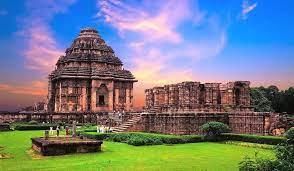 Context:
Context:
A duplicate of the Konark Wheel, inspired by the Sun Temple in Puri, Odisha, provided the backdrop for the Prime Minister of India's welcoming handshake with G20 leaders upon their arrival at the summit venue, Bharat Mandapam.
Regarding the Konark Temple wheel
- Constructed in the 13th century under the rule of King Narasimhadeva-I, the Konark wheel, featuring 24 spokes, is intricately integrated into India's national flag, representing the nation's profound wisdom, sophisticated civilization, and architectural prowess.
- The rotational movement of the Konark Wheel signifies time, Kalachakra, and the concepts of progress and perpetual transformation. It stands as a potent symbol of the democratic wheel, illustrating the steadfastness of democratic principles and a dedication to societal advancement.
Key facts about Konark Sun temple
- It is located on the eastern shores of the India.
- It is the culmination of Kalingan temple architecture, with all its defining elements in complete and perfect form
- It was built in 1250 CE by King Narasimhadeva I (r. 1238-1264 CE) of the Eastern Ganga dynasty.
- The temple in its present state was declared by UNESCO a World Heritage Site in 1984.
- The word 'Konark' is a combination of two Sanskrit words kona (corner or angle) and arka (the sun).
- It thus implies that the main deity was the sun god, and the temple was built in an angular format.
- The temple follows the Kalinga or Orissa style of architecture, which is a subset of the nagara style of Hindu temple architecture.
|
38 videos|5288 docs|1117 tests
|

